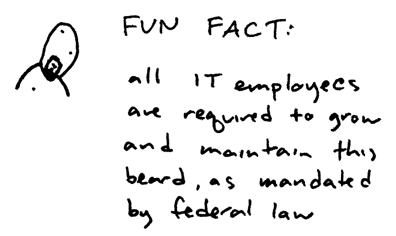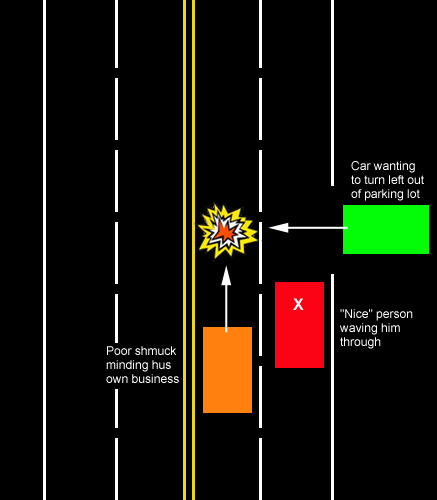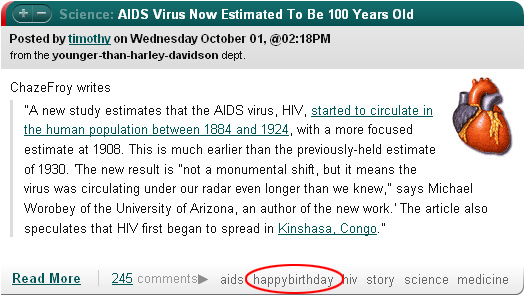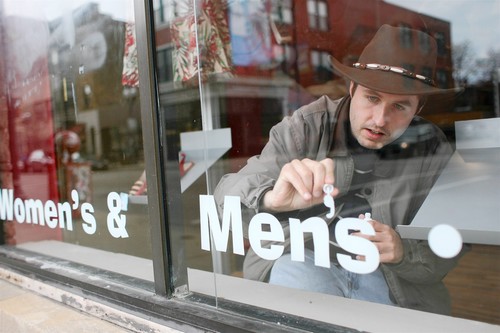I love Hallowe’en.
Category: General Swim
Flow Tip #2 – Driving
Not surprisingly, a lot of flow tips I hear are related to driving. It makes perfect sense – driving is an activity almost always done in concert with others, and the stakes are high.
Let’s consolidate a few of these tips into a single post. Remember, flow is about everybody getting what they want. In the context of driving this usually means each driver arriving where hu is going, efficiently and intact:
Speed – Observe the speed of traffic and determine what speed you are going to hold in relationship to it. If highway traffic is going 80 and you’re only comfortable doing 65, stay to the right or center lanes to the extent that these lanes allow you to hold your chosen speed. Choosing a speed and holding it encourages concentration, and makes your vehicle more predictable to others. Conversely, if traffic is going 60, trying to go 80 is a danger to yourself and others. Nothing gives you the right to put the unconsenting in harm’s way.
Passing – Regardless of your chosen speed, the passing lane is for passing cars, not time. Pass quickly and decisively, then get the hell out of the left lane. People who camp in the left lane because it’s more convenient (on account of not having to deal with merging traffic) are selfish assholes. For those who say, “If I’m in the left lane doing 75 in a 65, that’s plenty fast for anyone,” feel free to fuck right off. You’re not a cop and we’re not your responsibility. If you still feel compelled to inflict this duty, bear in mind that you’re breaking the law doing it, which is fine if you’re willing to deal with the consequences, but odd if you are misguidedly encouraging others to obey it.
Merging – If you’re in the lane that merging traffic is trying to merge into, try to get out of it. If you can’t get out of the lane, hold your speed. The person merging into traffic is responsible for adjusting hus speed to find an opening. If you’re the one merging, for the love of God, don’t stop in the acceleration lane unless it’s absolutely necessary. You’ll have a hugely easier time merging into traffic if you’re going approximately the same speed as everyone else, and you won’t crap up those behind you.
Right of Way – Promoting flow does not necessarily mean being nice. Right of way promotes flow in that it gives everyone a common set of rules to know who gets to go first. I witnessed an ugly accident a couple of years ago caused by someone being nice (breaking with the right of way to do so). Yes, the person who took the invitation was ultimately responsible, but the “nice” person who waved him through created the situation and drove away moments later unscathed.
Obviously, letting someone in when traffic is crawling out of a stadium at one mile per hour is different. Otherwise, please learn the right of way rules (especially for less frequent stuff like four-way stops) and stick to them. Apparently they do this quaint little thing in Boston where oncoming traffic yields to the first person in line to turn left at a common green. That just makes me not want to go to Boston.
Awareness – Get in the habit of taking frequent “snapshots” of the traffic behind and beside you, even when you are not contemplating changing anything. Ideally, in an emergency situation you should be able to change lanes and/or brake hard without first having to look around.
Intersections – This one is pure flow. On roads with which you are familiar, identify intersections that do not have dedicated right-turn lanes, but get a lot of traffic wanting to turn right. If you’re going straight, stay out of the right lane so as to keep it free for those turning right on red. It costs you virtually nothing, while potentially allowing several people to get where they’re going that much quicker.
The Search Continues
I frequently use the gender-neutral pronoun “hu” on this blog, and in regular speech and correspondence. The word’s creator is an old friend of mine and (in all its simplicity) I set up hupronoun.org for him. Periodically I scan the site’s web logs to look at the volume of traffic, and see what search strings people use to find the site. One unfortunate (but hilarious) discovery I made is that people find the site because they search on “pron” instead of “porn”. In some cases it might actually be an innocent typo, but “pron” (“pr0n”, actually) is Leetspeak for “pornography”, and was conceived to circumvent content filters (previously).
FTW, here are some of my recent favorite search strings from hupronoun.org:
- female pron
- gymnastics pron
- beautiful pron
- to young for pron
- flexible pron
- folk pron
- older women pron
- pron jobs for male
I scan my own web logs, too, because I find it fascinating to learn how people found me, and to speculate on what they actually were looking for. It’s also interesting to view in aggregate the span of subject matter I’ve covered over the years. Some of my favorite search strings from the last year:
- perfect shower temperature
- sociopath carnegie win friends and influence people
- how to handle post-consumption tampons
- cloaca (a surprising number of hits)
- ibonkedmymom
- how much does a 150-pound person weigh under the metric system
- midget porn
Happy memories all.
Damn it…
This was waiting for me when I got to the salt mines this morning:

I hate being predictable…
Literally
Okay, so I’m going to get this out of my system in one throw. While I have no intention of turning this blog into an Andy Rooney-esque, pedantic rant about word misuse, I nevertheless have bile to purge:
“Disinterested” means “a neutral party.” It’s a legal term and, like many legal terms, it sounds fancy, so those putting on airs seem drawn to it like a Senator to an airport lavatory. “Uninterested” by comparison, means, um, not interested. As in, “I am uninterested in watching the video of your colonoscopy, Bob.”
“Presently” means “in the immediate future,” as in, “Lady Funbody will be down presently, sir. May I take your hat?” It does not mean “now”, as in, “Thank you, but it’s presently covering my erection.”
“Actionable”. Another legal term. It means “affording grounds for legal action.” This one pains me particularly, since it has been assimilated into corporate-speak (meaning that I have to listen to it every day) and twisted to mean “realistic to execute,” as in, “Our strategy to enhance shareholder value has actionable objectives.” If you worked for Enron then it’s applicable. Otherwise, just stop.
“Begging the question”. This term describes a specific logical fallacy (in Latin, petitio principii). Unless you’re using it in that context, just say “inviting the question” instead. I recommend practicing this in front a mirror, reinforced with head slaps, for as long as necessary.
“Imply” versus “infer”. To imply is to suggest indirectly. To infer is to form a conclusion. However, the transposition of these terms is frequently hilarious, so feel free to continue.
“Literally”. Come on. We all know what “literally” means. So when you say, “I was literally slaughtered in that meeting,” I can only infer (see what I did there?) that you are a tease.
To respond preemptively to the useless argument that language evolves, and therefore if the majority of a given population uses a word in a particular way then that usage becomes correct – stop. You fail. Language does and should evolve. We require new words to describe new concepts and things. Trotting out this argument to excuse plain ignorance, however, is pure postmodern laziness, and people who do so should be bred for food.
Literally.
Flow Tip #1 – Voice Mail
Here’s a dandy little scheme to make the world a better place, you sons of bitches:
When trying to reach someone at multiple numbers (work, home, cell), only leave a message on the last number you try. Think about it, it wastes the least time of both parties involved, and gets the job done just fine.
My brain hurts a little when I get a message along the lines of:
Hi, it’s Bob. I wanted to blah blah blah blahdeblah blah blah. I’m going to try you on your cell.”
WTF, Bob? If you actually get me on my cell, then you will have blown 90 seconds of your time leaving a message, and 90 seconds of my time retrieving it. And for what? I have no idea where your sombrero is.
Hi, it’s Bob. My time is apparently worthless, and yours is an externality, so I’ll be leaving duplicates of this message on each of your numbers. Okay, bye.
I recently wrote a post on flow – when interacting with other people, making a conscious effort to make things flow better for everyone. While individual instances of flow-promoting or flow-impeding behavior may seem trivial, in aggregate they can have a powerful effect on one’s day. As the title of this post suggests, I intend to make this a series. Got a flow tip? Send it in and, providing it doesn’t suck, I will shamelessly steal and publish it as my own.
401 Special K
I wonder if opening a checking account with them increases future risk of heavier forms of investing…
Even More Slashdot Tag Humor
Stay classy, Slashdotters.
On Flow
If you’ve read the book or seen the film “Pay It Forward,” then the concept of engaging in selfless acts to make the world a better place is not new to you. I do this myself in small, practical ways. Given any public situation – driving, grocery shopping, walking down a hallway – I look for opportunities to make things flow better. This could mean offering to take someone’s empty shopping cart when hu is on the way out and I’m on the way in, or making an effort to ensure that no one has to apply hus brakes in reaction to a move that I make on the highway. Typically these actions cost me very little, but they are executed with the mindset of flow – conscious acknowledgment that I am one among many people, each of us trying to get from one place to another, or accomplish tasks simultaneously. New Yorkers, incidentally, have got this down pat. On an average weekday, New York’s public transportation system accommodates 7.5 million trips. That’s about as many breaths as you’ve taken in the last year. If a New Yorker is ever rude to you, there is a decent chance that you did something to impede the overall flow. With their throughput, if too many people were to engage in non-flow-promoting behavior, the whole city would promptly shit itself and gridlock.
This conscious approach to coexistence has become so ingrained that I feel physically uncomfortable (cringey) when I see people thoughtlessly, or otherwise, impede flow (asshole drivers, meanderthals and the like). I am not a confrontational fellow (too much like proseletizing), but I have taken to catching such people’s eye and giving them a small, disappointed shake of my head, trying to convey with gesture, “The world can be a very hard place to live in – all kinds of random shit can wear you down, or take you out of it altogether – so why the fuck are you making it just that little bit harder for the rest of us to get along in it?”
Opening my kimono a bit wider than usual, the idea that deists/atheists are amoral saddens me. I consider myself to have a strong sense of morality, one that I came by honestly and practice in daily life. Playing straw man a bit, I could counter an assertion made by a devout member of one of God’s many franchises that being godless is akin to being a sociopath, merely by pointing out that my values system is not based on some scary, eternal salvation/damnation model but on a highly practical, fulfilling effort to do good works simply because everyone benefits.
Honestly, which sounds more genuine? “Be virtuous, or you’re doomed to an eternity of fire and poking,” or “We’re all on our own, so why not lighten each other’s load a little”?
I’ve felt awkward the entire time I’ve been writing this. I am not smug, and I have no agenda other than putting an idea out there that might make a random passerby pause and reflect. Please, go delight someone for no reason other than that the world could stand to be more delightful, or that someone might appreciate having a little time cut off of hus commute.
Yet More Slashdot Tag Humor
Sweet Twelve-Inch Talking Poseable Jesus!
A friend of mine was recently burning away a bit of her soul shopping at Wal-Mart when she came across this:
The product description over at Amazon comes on a little strong, as if responding to the imagined question, “Jesus? Who the hell is Jesus?”
Jesus was the most important person in history. Ever. He was born in a manger, raised as a carpenter, and crucified on a cross. He healed the sick. He raised the dead…
And He had realistic eyes. And many, many points of articulation.
It’s hard to read the text, but just below “I Talk Try Me!” the packaging advises, “I come to life with just the push of a button.” Wow, that would make Catholic Mass a whole lot shorter…
One 2 Believe also sells a talking Mary, Moses, David and Esther (Esther?). If these sell well, perhaps they will expand the product line to biblical figures that I’d like to buy, and, for the love of poseable Jesus, make with some accessories. Right off the top of my head – Judas (tree), Lazarus (stone), Lot’s Wife (before and after), Jezebel (pack of dogs), Job (various sores), and John the Baptist (removable head) – and I haven’t even had my first cup of coffee.
One customer review let me know that I am not alone in my amusement:
This does get 5 stars for durability though. I’ve accidentally scratched or poked some holes in my Jesus, and within a couple of days, the plastic seals right up again. I don’t know what they used to make this, but it’s great!
Typo Eradication Advancement League
Okay, so this kind of sucks. A fellow named Jeff Deck, founder of the Typo Eradication Advancement League (TEAL), quit his job at MIT and went with his friend Benjamin Herson on a cross-country journey to correct typos on public signage:
What started as a wacky, quixotic adventure, covered by NPR, the Chicago Tribune and others, went South, or, rather, Southwest, in a hurry. On March 28th, Jeff and Benjamin corrected typographical errors on a 60-year-old, hand-painted sign at the Grand Canyon National Park (corrections not depicted):
Christopher A. Smith, a National Park Service agent (so much more respectful than Cactus Fuzz or Tree Pig), stated in an affidavit that investigators discovered that Deck and Herson were responsible via Deck’s own blog, which chronicled their exploits. Deck and Herson pleaded guilty and were sentenced to a year’s probation, during which they are banned from entering national parks, or modifying public signs. They were also ordered to pay $3,035 to repair the sign.
Having a mild obsession with signage myself (previously, previously, previously), I salute Jeff and Benjamin’s philosophy and mission, but I wonder if they feel, in hindsight, that they crossed a line. Jeff’s blog is currently dark, only stating, “Statement on the signage of our National Parks and public lands to come,” but there is still a gallery depicting some of their accomplishments.
Whether or not one has a problem with what they did depends on how one determines the value of a thing. One might argue that the sign in question has intrinsic value as art, whereas a restaurant sign with movable letters does not. The woman who painted the sign was Mary Elizabeth Jane Colter, the architect of the Watch Tower that the sign describes.
One could also argue that certain typos make documents unique, such as is the case with the numerous typesetting errors that gave rise to some highly collectible (and amusing) editions of the Bible, or the typos in the United States Constitution.







